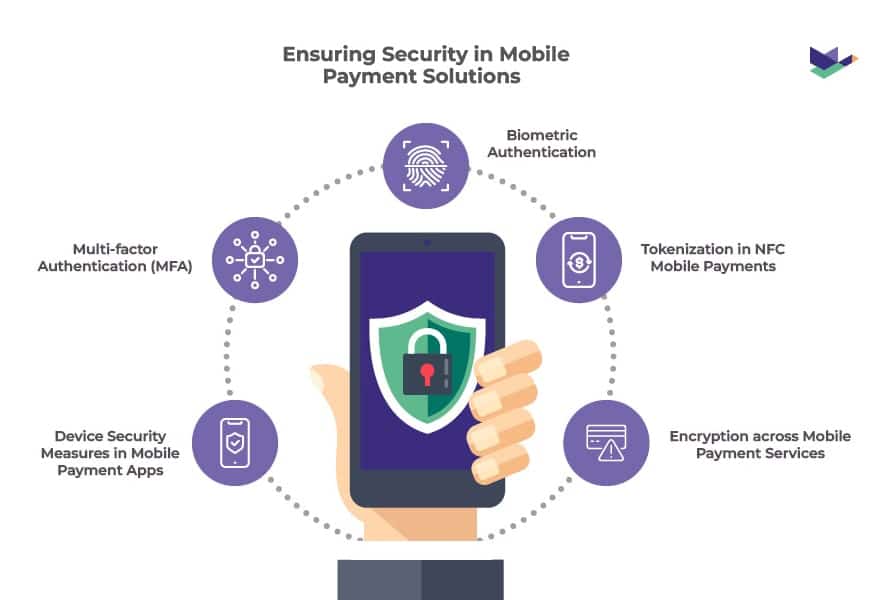In the ever-changing world of technology, mobile payments have become increasingly prominent. As smartphones have become essential in our daily lives, the way we handle transactions has also changed. Mobile payments, which include various methods and technologies, have emerged as a convenient and efficient way for individuals and businesses to conduct financial transactions. In this guide, we will explore the details of mobile payments, including their evolution, benefits, security measures, and future trends.
The Evolution of Mobile Payments
To fully appreciate the importance of mobile payment systems, it is necessary to examine their evolution from simple peer-to-peer mobile payments to sophisticated mobile money transfer and NFC (Near Field Communication) technology.
The mobile payment system innovation journey began with the introduction of smartphones and the integration of mobile wallets. These mobile payment apps allowed users to securely store their credit card information on their smartphones, enabling seamless and contactless transactions—reducing the need for physical cards, cash, and checks.
The emergence of mobile banking apps further accelerated the adoption of mobile payment technologies. Financial institutions created dedicated apps that not only provided traditional banking services but also included features like peer-to-peer transfers and mobile check deposits.
This shift made financial transactions more accessible and user-friendly for a wider audience, leveraging payment infrastructure to make mobile financial services more efficient and secure.
4 Main Types of Mobile Payments
Mobile payments are not a one-size-fits-all solution; they include various methods and technologies. Understanding the different types of mobile payments is important for both consumers and businesses. The main categories include:
1. Mobile Wallets Powered by NFC Technology
These applications, exemplifying cutting-edge mobile payment technology, securely store users’ payment information and facilitate transactions through NFC technology. Not just limited to retail transactions, mobile wallets like Apple Pay, Google Pay, and Samsung Pay have revolutionized the payment service landscape by offering a safe, contactless payment option that complements today’s fast-paced lifestyle.
2. Mobile Banking Apps for Financial Management
Crafted by financial institutions, these apps extend beyond conventional banking services by incorporating mobile payment solutions that allow users to manage payments, fund transfers, and account balances directly from their smartphones. They serve as a testament to how mobile application development in the financial sector has enhanced user convenience and financial management efficiency.
3. Peer-to-Peer (P2P) Mobile Payment Applications
P2P payment apps like Venmo, Cash App, and PayPal have become synonymous with mobile money transfer, offering a convenient platform for users to send and receive money virtually instantaneously. This type of mobile payment system leverages the internet and mobile payment technologies to simplify transactions between individuals, embodying the essence of digital financial interactions.
4. Mobile Point-of-Sale (mPOS) Systems for Flexible Merchant Services
mPOS systems are a boon for small and medium-sized businesses, providing a mobile payment option that transforms smartphones or tablets into fully functional POS systems. This flexibility allows merchants to accept payments on-the-go, enhancing business operations with mobile financial services and making it easier than ever to cater to customer payment preferences.
The landscape of mobile payment technologies is diverse and continuously evolving, presenting a plethora of options for both individuals and businesses. From secure NFC technology in mobile wallets to comprehensive mobile banking applications, and from streamlined P2P payment platforms to versatile mPOS systems, the realm of mobile payments is rich with opportunities for convenience, efficiency, and innovation. Understanding these different technologies and how they can serve varying needs is crucial in navigating the modern financial ecosystem.
5 Advantages of Utilizing Mobile Payment Systems
The integration of mobile payment technology into daily transactions offers several key benefits that cater to the needs of contemporary consumers and businesses alike.
1. Convenience of Payments
Mobile payments eliminate the need for physical wallets and cash, allowing users to complete transactions with just their smartphones, making everyday purchases simpler than ever. The inherent convenience of using NFC mobile payments means you can effortlessly tap to pay, streamlining the checkout process even in the busiest environments. This ease of use promotes a more fluid and less cumbersome shopping experience, particularly in on-the-go situations.
2. Speed and Efficiency of Payment Processes
Mobile payments are typically faster than traditional methods, processing transactions with remarkable speed. This efficiency is particularly evident in busy retail settings, where NFC mobile payments can significantly reduce queue times, enhancing the shopping experience for everyone. Faster transactions contribute to higher customer throughput, benefiting both consumers and businesses financially.
3. Enhanced Security with Advanced Payment Technology
Mobile payment methods incorporate sophisticated security measures, such as biometric authentication and tokenization, to safeguard transactions. These advanced payment technologies provide an added layer of security, making mobile payment solutions among the most secure options available today. This means even in the event of a lost or stolen device, unauthorized access to payment methods is significantly minimized.
4. Expanding Accessibility with Mobile Financial Services
Mobile payment systems bridge the gap in accessibility to financial services for populations formerly excluded due to the absence of traditional banking infrastructure. This democratization of financial services extends the benefits of mobile financial services to underserved regions. By enabling financial inclusion, these platforms can stimulate economic development and growth in previously marginalized communities.
5. Efficient Expense Management via Real-time Tracking
The capabilities of mobile banking apps to offer real-time tracking of expenses and transactions grant users unparalleled control over their finances. This immediate transparency is instrumental in fostering responsible financial management and planning. This real-time insight allows for immediate adjustments to spending behavior, encouraging better financial health.
By taking on these diverse benefits, mobile payment options not only streamline financial transactions but also reinforce the security and efficacy of the payment infrastructure, making them an indispensable component of modern financial dealings.
Ensuring Security in Mobile Payment Solutions
Despite the convenience and efficiency of mobile payments, security remains a top concern for both users and businesses. Mobile payment providers employ robust security measures to safeguard sensitive information and ensure a secure transaction environment.
The implementation of rigorous security measures is crucial in fostering trust and safety within the mobile payment ecosystem. These safeguards protect against potential threats and ensure that mobile payment transactions are both secure and reliable.

1. Biometric Authentication
Many mobile payment apps now incorporate biometric authentication, leveraging fingerprint and facial recognition technologies to uniquely verify user identity. This method not only enhances security but also streamlines the authentication process.
2. Tokenization in NFC Mobile Payments
Tokenization technology, a fundamental security feature in mobile payment services, replaces sensitive data like credit card numbers with unique tokens. This process significantly decreases the risk of sensitive data exposure.
3. Encryption across Mobile Payment Services
Encryption ensures the secure transmission of payment information, making NFC mobile payments and other mobile payment options safer for users. End-to-end encryption is a critical component in protecting data privacy.
4. Multi-factor Authentication (MFA)
MFA requires users to authenticate through multiple verification methods, thereby reinforcing the security of mobile payment systems. This approach significantly reduces the likelihood of unauthorized access to user accounts.
5. Device Security Measures in Mobile Payment Apps
Collaborations between mobile payment solutions providers and device manufacturers have led to the development of advanced security features, such as secure storage elements designed to safeguard payment information at the hardware level.
With these advanced security measures in place, mobile payment systems and apps offer users a secure and reliable platform for managing their financial transactions. The integration of technologies like biometric authentication, tokenization, and encryption ensures that mobile payments are not just convenient but also secure, making them a preferred choice for consumers and businesses alike.
Navigating Challenges and Concerns in Mobile Payment Platforms
While mobile payments offer numerous benefits, there are also challenges that need to be addressed for widespread adoption and acceptance.
Understanding and addressing the concerns within the mobile payment industry is key to enhancing the security, standardization, and adoption of these technologies globally.
1. Security Concerns in Mobile Payment Solutions
Even with advanced security features in mobile payment apps, the industry must continually evolve to combat threats like fraud and data breaches. Ongoing enhancements in security protocols are imperative for maintaining trust in mobile payment systems.
2. Standardization Across Mobile Payment Systems
The diversity of mobile payment solutions and technologies necessitates a move towards standardization to simplify the user experience across different NFC mobile payment systems. Achieving this would further facilitate seamless payment integrations worldwide.
3. Boosting Consumer Confidence Through Education on Mobile Payment Security
Educating consumers about the security and efficiency of using mobile payment services is critical. Enhanced awareness and understanding will accelerate the adoption of mobile payment options, including peer-to-peer mobile payment applications.
4. Overcoming Infrastructure Challenges for Mobile Payment Adoption
To ensure broader accessibility of mobile financial services, significant investment in digital infrastructure, particularly in underdeveloped regions, is essential. This will support the expansion of mobile money transfer services and other mobile payment technologies.
5. Navigating the Regulatory Landscape for Mobile Payments
Adapting regulatory frameworks to keep pace with the evolving mobile payment infrastructure is crucial. Clear regulations will safeguard consumer interests while fostering innovation in mobile payment options and services.
By addressing these challenges, the mobile payment industry can continue to grow, offering secure, efficient, and inclusive financial solutions globally.
Future Trends in Mobile Payments Systems
The future of mobile payments holds exciting possibilities, driven by technological advancements and changing consumer preferences.
1. Integration of Emerging Payment Technologies
The advent of blockchain and AI within the realm of mobile payment systems is poised to bolster security measures and streamline transaction processes. Blockchain’s inherent security and AI’s predictive algorithms could dramatically reduce fraud and improve user experience in mobile payment apps. These technologies are anticipated to bring about a significant reduction in the incidence of fraudulent activities while simultaneously enhancing the speed and reliability of transactions.
2. Expansion of NFC Contactless Payment Options
NFC technology, a linchpin in the evolution of contactless mobile payment solutions, is expected to see an upsurge in usage. This forward momentum is driven by a collective pivot towards faster, more hygienic transaction methods in the wake of global health concerns. The shift towards contactless payments is largely motivated by an increased demand for safe and swift payment alternatives that minimize physical contact.
3. Continued Growth of P2P Mobile Payment Apps
The ease and convenience of P2P mobile payment services continue to encourage its proliferation, transforming the way individuals exchange money, thereby enhancing the robustness of mobile financial services. This trend reflects a growing consumer preference for instant and easy-to-use financial transaction methods, eliminating the need for traditional banking procedures. This trend reflects a growing consumer preference for instant and easy-to-use financial transaction methods, eliminating the need for traditional banking procedures.
4. Wearable Technology Integration with Mobile Payment Systems
The integration of mobile payments with wearable devices, such as smartwatches and fitness trackers, is gaining popularity. This allows users to make transactions with a simple gesture, further simplifying the payment process. Wearable devices offer an added layer of convenience by enabling users to carry out transactions without the need to physically handle their smartphones or payment cards.
5. Enhanced Personalization in Mobile Payment Options
Mobile payment providers are likely to use data analytics and AI to offer more personalized and targeted services. This could include tailored promotions, loyalty programs, and financial management insights based on individual spending patterns. Personalization is becoming a key factor in attracting and retaining customers by offering them value that is specifically aligned with their preferences and financial habits.
The Future is Mobile: Evolving Payments for Tomorrow
The landscape of mobile payments is dynamic, marked by rapid advancements and a shift towards more inclusive, efficient, and secure financial transactions. As we look towards the future, it’s clear that the integration of cutting-edge technologies such as blockchain, AI, and NFC alongside user-focused innovations like wearable payment devices and personalized financial services will play a pivotal role in shaping the financial industry.
These developments promise not only to enhance the security and convenience of transactions but also to democratize access to financial services on a global scale. Ultimately, the continued evolution of mobile payments is set to redefine our relationship with money, making it more integrated into our digital lives than ever before.
With Duck Creek Payments at the forefront, we’re committed to supporting this transition, ensuring that insurers and their customers can seamlessly adapt to and benefit from these emerging payment technologies.





